

Noyhauser
-
Posts
1581 -
Joined
-
Last visited
Content Type
Profiles
Forums
Events
Gallery
Posts posted by Noyhauser
-
-
I screwed up and got some damn superglue on my acrylic YetiStands...it kinda marred the surface and looks like sh*t. I tried Goo Gone, paint thinner and Windex....anybody got any better ideas or am I screwed???
Unfortunately, its likely that you are. Superglue will fog up clear parts, to the extent that they change their chemical composition. You can't do much about it either... sanding it down won't do much, especially if you dropped it directly on it. Its a problem for Vacuform canopies, which need a strong fastener, but are easily damaged by CA fumes or direct contact.
For future reference, you can prevent some damage if you put a coat of future down first. It acts as a protective barrier that will prevent serious fogging and crystallization.
-
Would air regulators be usable with compressors of different brands? For instance, would a regulator from Anest Iwata be usable on a Sparmax compressor?
I was just thinking that since the connection joints between the compressors and regulators are all universal sizes (1/4"), and regulators simply control how much air flows from the source into the hose, it shouldn't matter what brand it's from.
It really depends on the connectors; if they fit they fit. Air pressure is air pressure after all.
Oh, and one more thing!
When I turned on my comrpessor this morning, I caught a slight hiss for LITERALLY a split second around the area of the regulator--I repeated turning my compressor on and off (draining the tank and turning the power off, and turning it back on), and it only happens during startup. I wrapped some Teflon tape around the threads of the joint that connects the regulator to the airbrush's air hose, which solved the hissing, but the needle still drops by 7 psi.
Could this be a faulty hose, after all?
Do you have a water trap? they need to hit a certain pressure before the valve seals, which is pretty common.
-
Thanks for the tips, Noyhauser!
The other problem I have is that the finish as smooth as I'd like it to be. I guess I have a habit of not going heavy or close enough, but I almost always end up buffing with toothpaste to get rid of any minor orange peel.
Often a coat of future overtop of that will just get rid of it too.
-
He's a man of good tastes, I see.

Just out of curiosity, why bother with an airbrush? Isn't it actually harder to airbrush bright glossy colors than to just use a rattle can?
Maybe it's just my inexperience, but I still need to buff any gloss finishes with toothpaste and paint on a coat of FFP to give it that "showroom shine." And at that rate, I might as well save myself the hassle of cleaning up and go with a rattle can. Airbrushing does save a lot of paint, though. The only time I'd decant is if the paint is hard to get or expensive, like Tamiya TS sprays.
Acrylics can be glossed through a number of methods. You can add a paint retarder, which will allow time for the paint to smooth out (gunze and tamiya sells such products), or an different additive that I think breaks the tension down and allows for glossing to occur. The other option is to use gloss coat afterwards... like future or Alclad Aqua gloss. Plenty of ways to get a nice glossy coat with acrylics.
-
Very cool and very well done! The SDF is no slouch whatsoever.
-
Modern Hobbies is pretty great.. the service I got was fantastic. I've got a few more of their products to use in the near future (F-117, F-2, among others) , which I'll post on the forums.
-
So its been awhile... some pretty cool things going on around here I see... like those parts from Derex... very nice.
I've been a bit busy but tried to plow through some kits over the past few months. Probably the main kit I worked on was a 1/72 Hasegawa CF-104.
Cockpit:
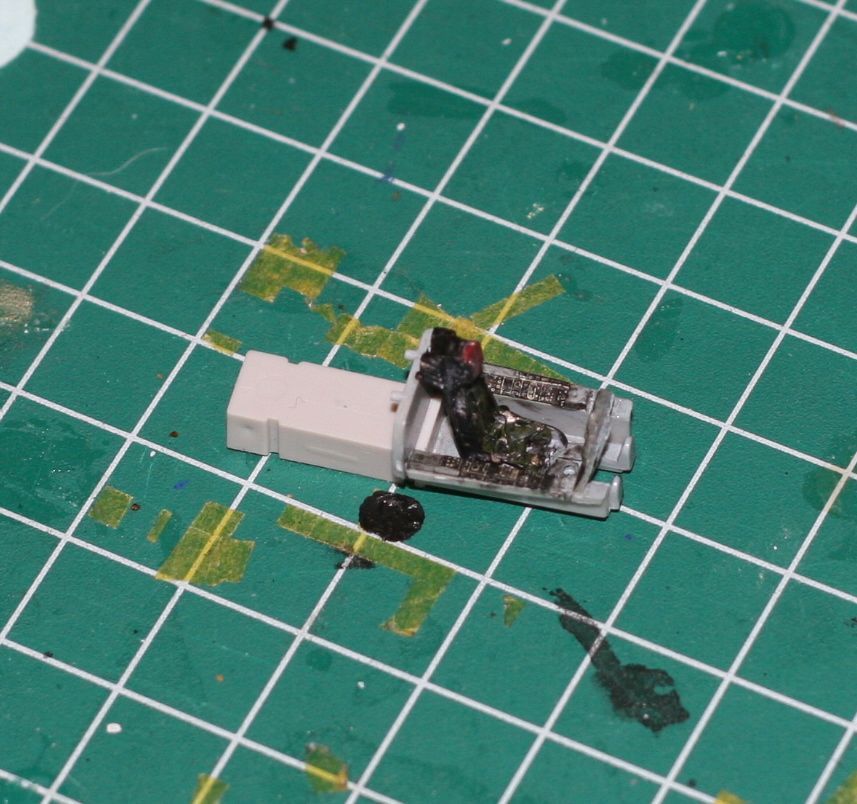
Fuselage:

Wings n'stuff with first colour:
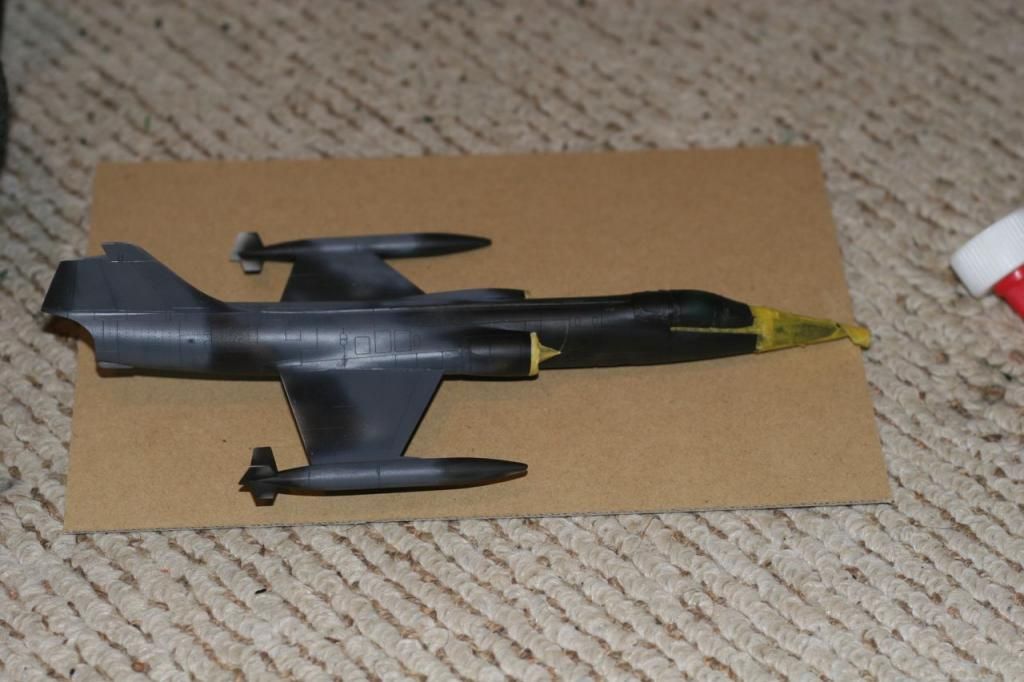
Painted:
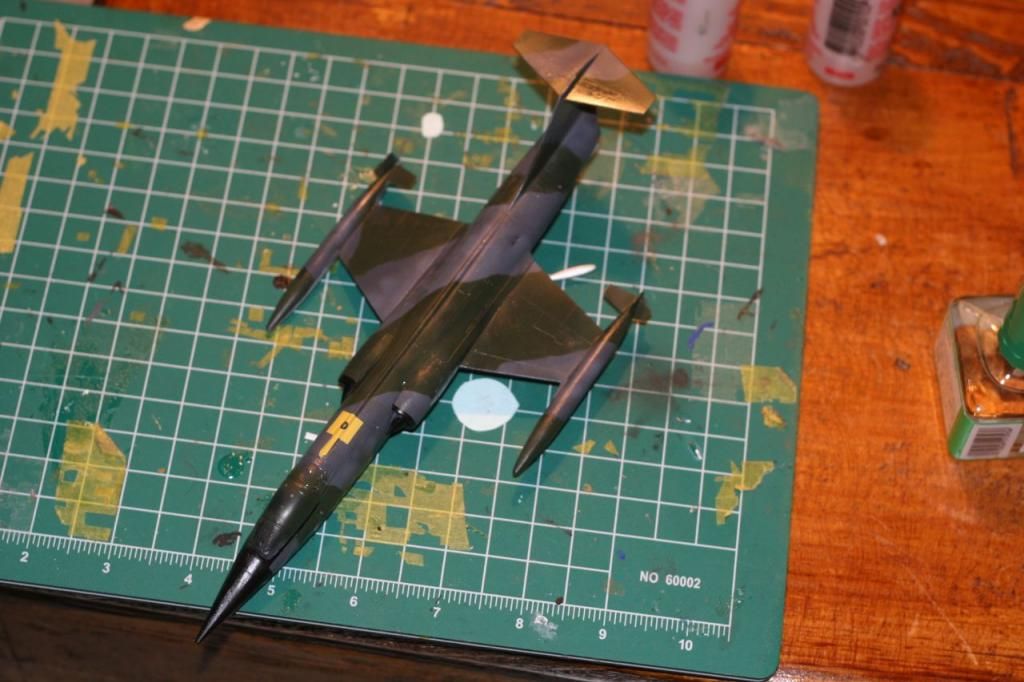
Annnnd done:
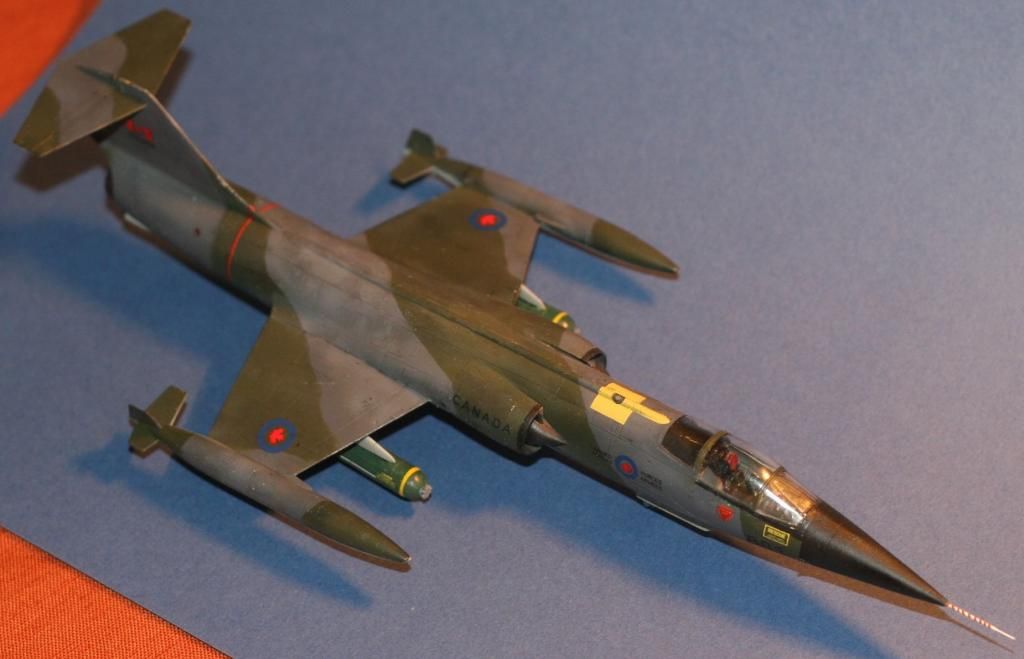
Sorry for the crappy photo quality... I really need to learn how to take better photos.
I also built this B5N2 kate... which has taken me ages to get right because of the extensive amount of PE for the wing folds and everything else.
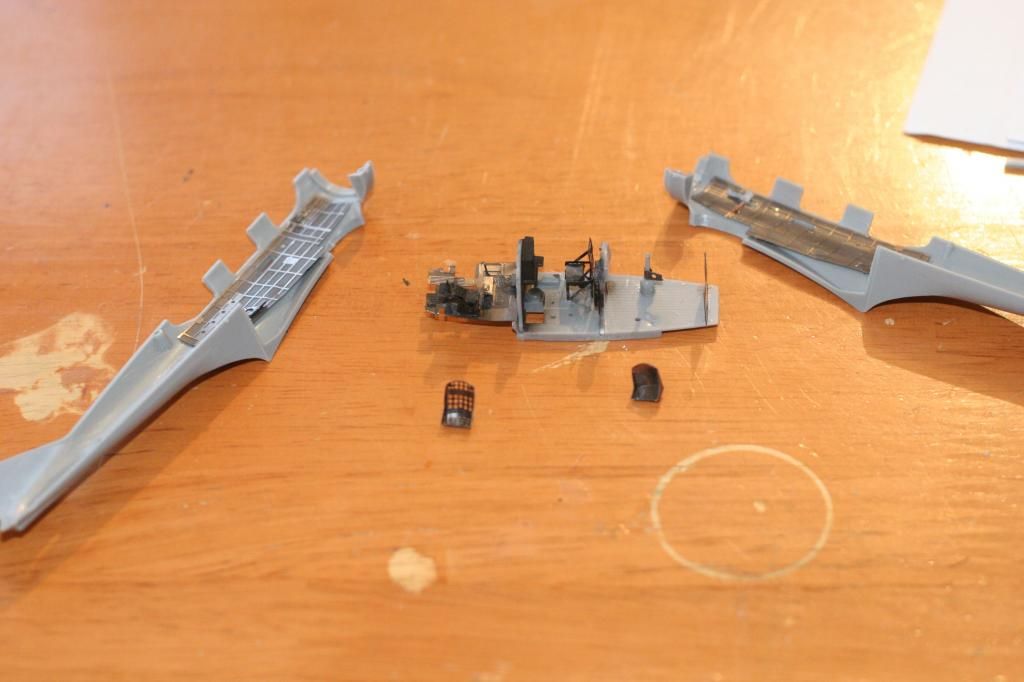
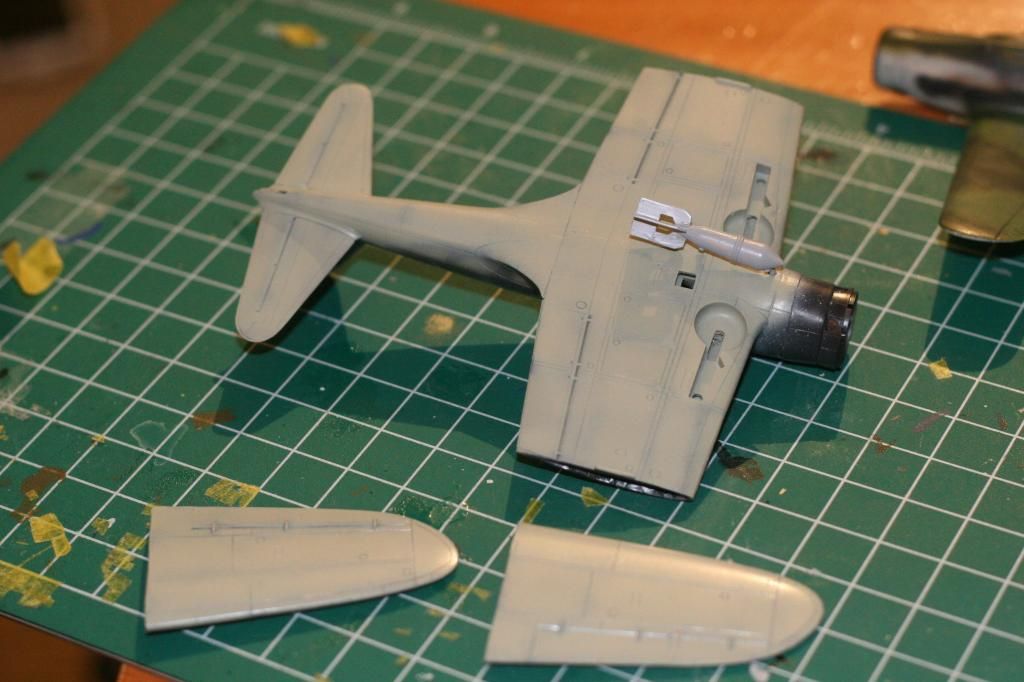
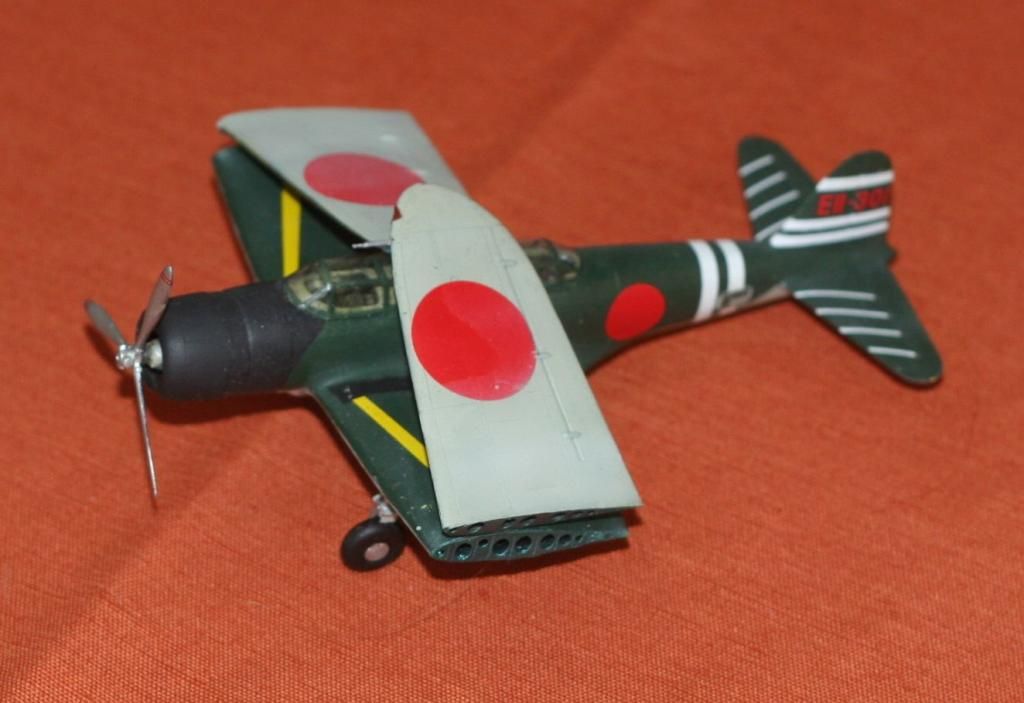
So, now I'm working on a couple of things... probably the most interesting for you guys is this kit:
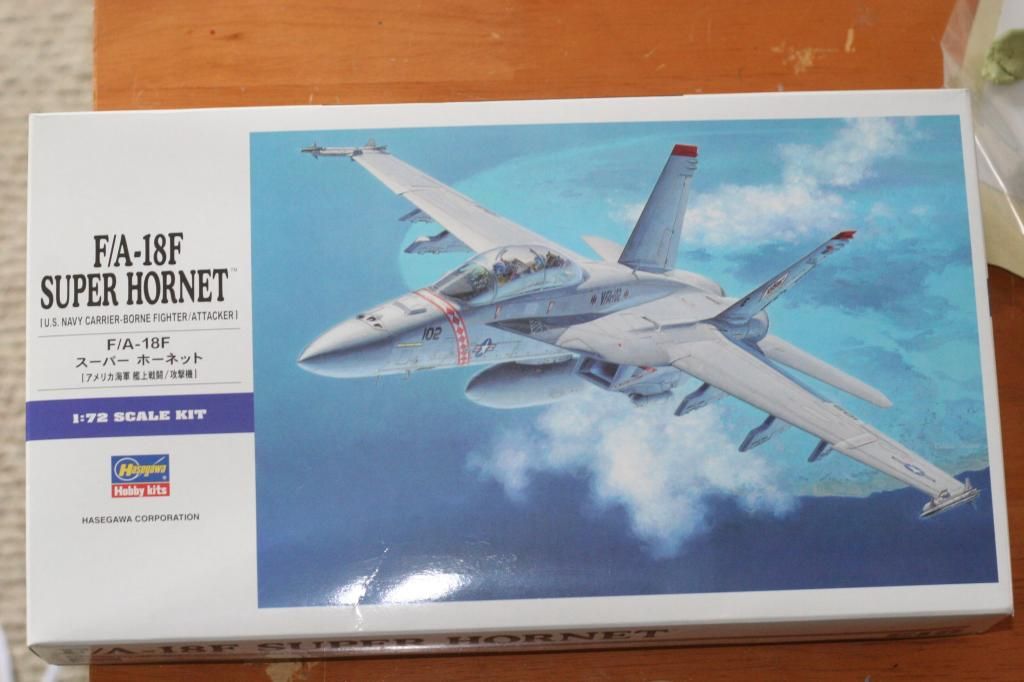
I'm building a VFA-2 Bounty Hunters scheme from around 2005 in this scene:
.jpg)
I built the intakes from miliput:
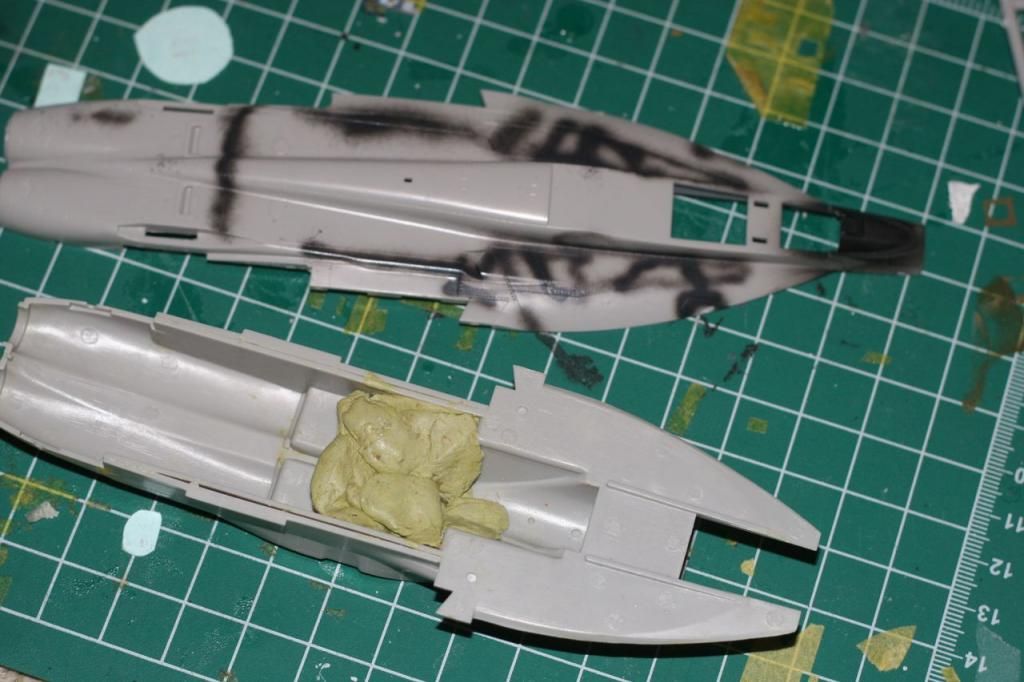
Added some pilots from Modern Hobbies:
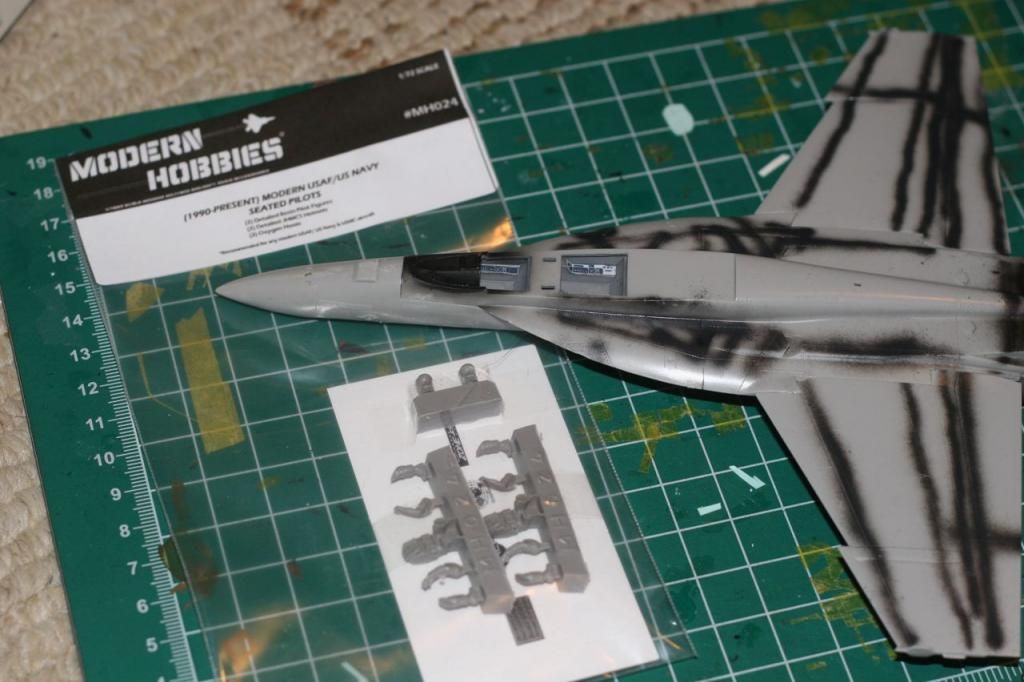
I painted them and made their oxygen hoses by wrapping thin copper wire around a somewhat thicker wire.

And this is where I'm at today:
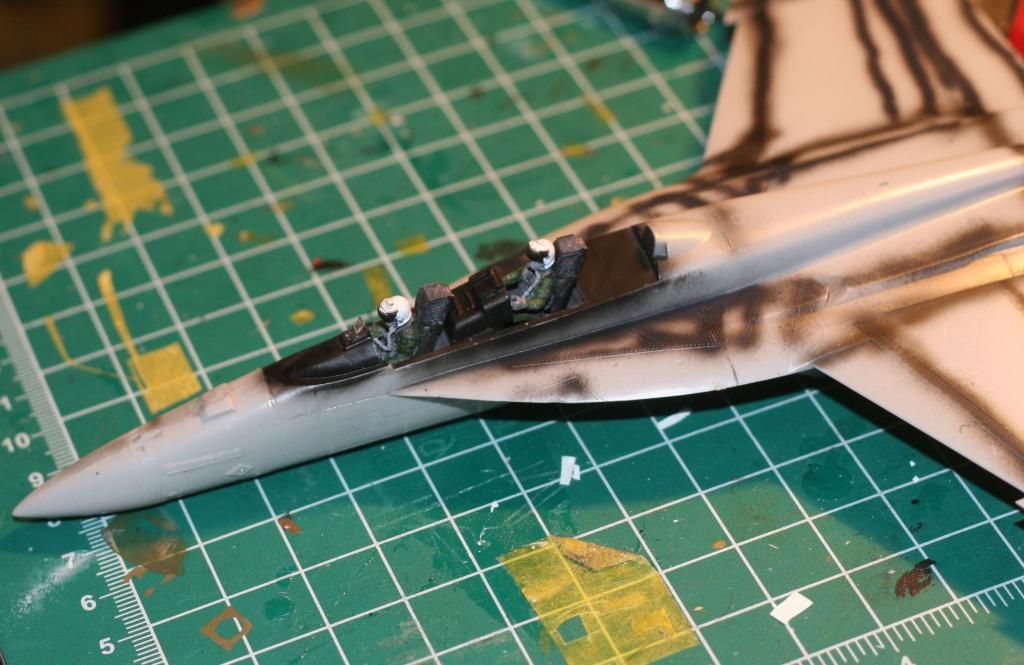
That's all for now, thanks for looking.
-
Would the Revell 39199 set with compressor @ 100 be OK to start with?
For example:
Or would I be better off with something like a Iwata Neo and a second-hand compressor?
My LHS has the Revell and provides good support...
Hi Quagga... sorry for the late reply.
I'd go with a second hand compressor and a Iwata Revolution CR. Its a higher quality AB than the NEO, and can be found at really reasonable prices second hand. Its how I started modelling seriously... and I still use the CR to this day for large area painting. I guess I would suggest you do a fair bit of research on a model before you buy it. I bought a Senco PC1010, which is a really highly regarded compressor at a really reasonable price in the U.S. However it might not be as cheap in Europe. Really it is a question of what might be available for you.
-
I hate to burst any bubbles, but the reason we never sold the F-22 to other nations, beyond security, we knew it was flawed from the get go and didn't want that getting out. The F-22 is a marvelous piece of tech and an innovative stealth design, but has some serious fundamental flaws that are just now reaching public attention.
Are we talking about the avionics? Because those were fairly apparent early on, but the issues with the design, and lack of gov't spending have really killed a proper fix. I also believe that this is why the F-22 production was capped; it would require an expensive redesign to build additional avionics sets.
Given this and the other issues, I wouldn't be surprised if the F-22 fails to reach its planned life and is retired early (like in 15 years). I hope I'm wrong but as someone who has been keenly interested in the file for the last decade, I don't hold out much hope.
-
The smaller wings are a concession for the stealth attributes the USAF is super hard-on for. Bigger wings present a higher stealth profile, and there isn't much you can do with design to cut it, leaving only expensive stealthy materials to absorb radar, and even those will only do so much. The Navy is less concerned with high passive stealth and more concerned with a usable aircraft, so the 35C has big wings. The Air Force doesn't absolutely need the big wings, so they opted for the higher-stealth tiny-wing variant.
The B variant shares similar wings because cost cutting. This isn't an F-22 where we can make it out of unicorns and gold-plated turboencabulators, it does have to meet cost requirements. (Which it's still having a hard time with)
No, that's entirely incorrect.
Size has an near infinitesimal effect on observability. you can have an infinitely long wing and angled correctly it won't matter. Conversely, an incorrectly positioned panel a few centermeters across will be detected by most modern fighter radars.
Wing size is completely dependent on the navy's need for low speed handling, versus the general balance of flight characteristics that the AF wants for its version.
If I can go back to Mr. Sprey's critique of the F-35, something else had been bothering me. He places a lot of emphasis on its (supposed) lack of maneuverability, and ties this directly to its small wings and high wing loading.
Now, I realize that this is a gross oversimplification of the aerodynamics that contribute to maneuverability (if that can even be generalized as a single attribute), but it's not completely invalid. There is a problem even with this argument, however: the F-35C. Because the naval version of the F-35 has considerably greater wing area as well as larger control surfaces, can we safely assume that it had a lower wing loading and correspondingly better performance in attributes like turn radius? And, if this were a true detriment to the "base" F-35 airframe, why wouldn't the Air Force version, the F-35A, use the larger wings?
Going further, what is behind the small wings, anyhow? Mr. Sprey indicates these are a concession to the VTOL design, and looking at the few existing VTOLs I'm inclined to believe that, but why? Surely speed in vertical flight is so low that the drag of larger wings in this direction can't be significant (plus they can serve to trap some air when the craft is low enough for ground effect). Is it mainly about weight?
The best I can figure is that the downsides of the large wings for ANY version of the F-35 would be drag in forward flight/reduced speed, increased weight, more low-level, high-speed turbulence, and (to a minor degree) cost. The benefits would be superior maneuverability (particularly low-speed handling and reduced stall/landing speed), greater range from both higher lift and increased fuel space, and maybe a slightly higher ceiling.
Does that sound right? And, if so, does it make sense that the F-35A is sharing the wing of the F-35B instead of the F-35C? I'd love to hear your thoughts.
The reality is that Sprey is wrong and an exceptionally biased information source. Even in the 1970s he was discredited as an analyst. He was dead set against the F-15 and F-14, as being too complex... even the F-16 was seen as being excessively weighted down. Today he claims that he was "designer" or key influencer of it and the A-10, which is just not true. But lets get onto the thrust of his arguments.
First his calculations on wing loading did not include the F-35' fuselage, which is a lifting body, as you noted in the F-14 case. That changes quite a bit. Second, there is so much more to air combat to wing loading. In reality sustained turn is not the most sought after performance metric. The advent of all aspect, high off boresight missiles, basically has switched what performance variables matter relative to others. Rather than Acceleration and sustained turn being prized, Acceleration and instantaneous turn have become more important as these allow for sudden movements that can help an aircraft point its nose towards an adversary faster, or to quickly reposition itself on the defensive. Others that have increased in importance are High G Roll rate, low speed nose authority (post stall/high AoA conditions), time to corner speed.
So, back to your question, the current wing design basically is a trade off that enables the aircraft to have the performance in those other realms. Smaller wings basically aid in acceleration, instantaneous Turn, high G, ect... all the stuff that have become more important for current air combat.You won't see great swirling dogfights of the old. Rather it will be a few violent turns within close quarters with one or both aircraft going down. That's not to say that the F-35 doesn't have a good sustained turn rate.. most of the comparisons are made with the early F-16 blocks, which were extremely maneuverable. Its just not as valuable as it was before.
As a final point, The JSF's real concession wasn't the B version, that's a fallacy. In reality the biggest concession came from the C version, because of the extra reliability requirements the navy imposed on the aircraft. ITs heavier today because the Navy wanted an excessive amount of redundancy built in for carrier operations, including reinforced structures throughout the airframe.
Hmm, I thought that with proper stealth shaping, the physical size of the object was not very important, because you had minimized its reflection in a given aspect (or aspects). It's like looking at a piece of paper - if it's exactly edged-on, you can barely see it, and it doesn't matter much if it's the size of a business card or a poster board (assuming hypothetical paper of the same thickness that doesn't warp). A stealth aircraft is shaped to be as close as possible to the reflective equivalent of that piece of paper in the "eyes" of a radar at the most likely angles of interception, and likewise to confine any necessarily reflective aspects to a few discrete angles. So, the size of the wings shouldn't matter very much to its stealth, unless we're talking specifically about those least-optimal scenarios.
Or... maybe I don't get this at all. Stealth is some pretty hazy stuff.
A good primer is Rebecca Grant's the Radar Game, which she updated in 2010.
https://secure.afa.org/Mitchell/reports/MS_RadarGame_0910.pdf
-
All of that post completely ignoring the fact that Boeing is still building F/A-18s, and that the Block III shares very little in fact with the Block II architecture, which is practically a different plane in vaguely the same shape as the F-18.
In reality AMC III on Block III is not really close to the capability as the 3i avionics package that will be installed on F-35 after 2017. Its data will still be presented in a semi-federated state to the pilot (not fused in the way that the F-35's will be), and it too uses the MILSTD 1335 Databus which limits the amount of data that can be transferred. The biggest enabled capability is a digital touch screen and cockpit displays, and some processing capabilities, but it still is limited in a whole bunch of key areas.
Moreover the F/A-18E won't be produced for much longer. The Navy wanted 22 additional EA-18Gs (not F/A-18Es) in its unfunded priorities list this year, and it got 5. In reality the US Navy hasn't made a large purchase of F/A-18E/Fs in several years and the EA-18Gs will primarily be tasked to jam for the existing F/A-18Es . The five units staved off the line closure for an additional year, but its almost certain that the St. Louis plant will be closed down in 2017.
But really, you're saying the reason the F-35's avionics upgrades can't be applied to any other plane is because they don't have super-USB?
Its not a USB: the Databus is a critical component for bringing in data from federated sources: RWR, Radar, LANTIRN/LITENING pods, weapons, Comms, diagnostic sensors, among other things and sending processed information to flight displays, automated systems and communication. This is the Eurofighter's Avionics infrastructure diagram:
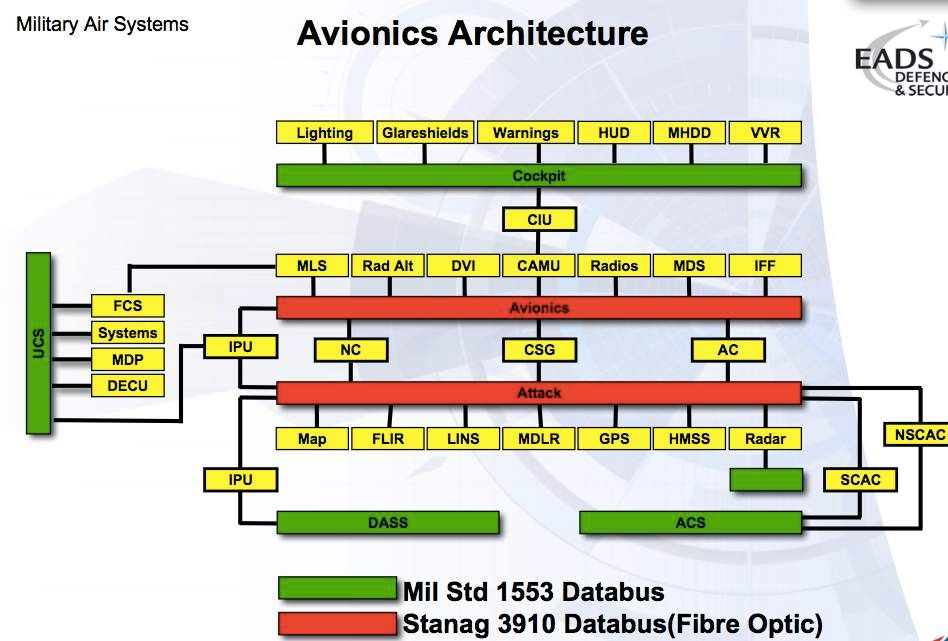
Those red and green boxes are the data buses; They are integral to the functioning of a fighter's avionics system. In the case of the F-22, they actually fused the radar with the core processor in order to improve the data transfer rates. So being dismissively flippant about the quality of data bus really illustrates your lack of understanding of this area.
-
I'll be very interested to see the actual RAAF F-35 delivery numbers in the 2020's.
Prime Minister Abbott announced that 72 will be purchased. Since the deliveries will start in 2018, and so the RAAF has already started major planning for acquiring the fleet. Its basically a year or so away for them to start training their initial cadre of pilots. I'd say that 72 is likely what you will see in 2022, especially considering that the RAAF F/A-18A fleet will need to be replaced by 2022... as Australia does not have a centre barrel regeneration facility like the RCAF does in Mirabel Quebec. So those aircraft are life limited to that time.
For medium sized air forces like Canada and Australia, decisions like this are not taken likely. You have an established force structure that isn't easily tinkered with: airframe life, aircraft capability, availability and personnel arrangements, just to name a few. That means an announcement like this is very likely to be followed through... especially given the broad political agreement over the procurement.
-
But it states that it gives "real-time imagery" (not just data) via infrared cameras.
https://www.f35.com/about/capabilities/missionsystems
Unless I'm reading wrong, it does suggest that the pilot can literally "see through the floor".
Found this:
http://www.rockwellcollins.com/sitecore/content/Data/News/2014_Cal_Year/GS/FY14GSNR44-F35.aspx
ITs not just through the floor, its basically a 360 degree spherical view around the aircraft utilizing an electro-optical system. The biggest value is the sensor fusion, so basically it will take information from other sensors, both onboard and off board and present that information to the pilot through the helmet system. That's unprecedented.
With all that being said, is there any reason any of that would be inherently unique to the F-35 anyway? It's not something radical to the airframe- you could put that in any plane. And you'd probably actually reach production in another aircraft.
It is for a number of reasons. First you need to basically run sensors all around the aircraft, power them, and then build an avionics and helmet system that takes all that data. That isn't really unfeasible, but its actually very costly and difficult to do. Its not being retrofitted into any other aircraft.
The real challenge is to integrate that data into the overall sensor picture. Most aircraft do not possess computing power/architecture to integrate such a system. The F-22 and F-35 are the only aircraft with a IEEE 1394 firewire data bus that can handle the sort of data that is required to make such a system a reality. it might be possible to run a separate system outside of the core legacy avionics system, but it wouldn't have any fusion with other sensor systems, which is the real benefit of the DAS system. Some test F/A-18F attempted this, where they basically ran a firewire line from optical systems to back seat laptops... but that is limited in its capability and really only represents a narrow capability, nothing like a secondary DAS-like architecture without sensor fusion.
So its really not possible.
The F-35 is in production in the same way that the highways around D/FW are under construction. Technically, yes, but we still don't really have anything to show for it.
There have 120+ training aircraft, which are starting to produce new pilots and crews for the aircraft. Moreover by July or August of next year the first operational squadrons will start to come online in Yuma.
By the same token, a lot of the foreign powers who pledged to buy it are having second thoughts.
Some, but this is balanced by new countries coming online and purchasing in larger than expected volumes.
With the F-16 and F/A-18 still in production and receiving updates, is a 5th-gen fighter strictly necessary? Especially considering who the actual intended buyers are. We keep talking about an "aging fleet" but really, what does it matter?
Oh it really matters. Basically aircraft are time limited by their airframe, which can only take a certain amount of flight time and Gs before they cannot be used anymore. The RCAF's CF-18s are basically representative of that, Early on they were flown extremely hard by pilots: they would regularly pull 9Gs and undertake multiple touch and go hard landings. It was quickly discovered that the aircraft were rapidly eating up their usable flight life and whole new flight restrictions were put into place.
Now we basically fly them like classic cars: they rarely see more than 4Gs, they are equipped with very specific loadouts and landings are conducted with a gentle flare touchdown. They are literally at the end of their lives and we need to soldier on. The USAF does not have the same regimented regulatory system on their F-16 fleets, but many aircraft are being retired at 5,000~6,000 hours, instead of the 8,000 expected lifespan.
Sad but true--what I call the "Ace Combat effect" is proving true. That is---the aircraft itself matters little, it's all about the sensors/weapons it uses.
Most current modern European F-16A's, are the F-16A MLU now. They are much better planes than an initial F-16C.
The F/A-18A+ is better than all but the very latest F/A-18C's.
None of these are airframe differences really, purely avionics and weapons upgrade.
So why are you paying a zillion dollars for an ASRAAM-carrying F-35 w/AESA radar, when you can pay a whole lot less for a Super Hornet that does the same, and is faster and more agile? That's what the RAAF did.
The Super Hornet is not faster, more agile or "as capable." If the Shornet is clean, its likely faster, but not more agile and certainly not as capable (especially in range or with weapons). Basically if you hang anything on the Rhino, its performance drops dramatically. With tanks, it could not get to M1.6... at least not without a dive. It doesn't have anything approaching sensor capability or comms that the F-35 has. And in reality the cost is likely on 20% less than the F-35.. maybe. Weigh that with better capability and higher sortie rates, and its really not a bargain at all. Much of those claims are basically Boeing business development talking points, which basically use a clean F/A-18E (without pods of external fuel tanks), using 2000 base year costs and comparing them to the F-35's 2012 base year costs.
The RAAF only purchased the Shornet because of the early withdrawal of the F-111: basically it was a gap filler. Its force structure in 2022 will be 24 F/A-18F (12 or 24 being EA-18G configuration) and 72 F-35. So its really not what the Aussies did.
-
So I'm in San Fran this week for a conference (you know which one) and I have some time thursday afternoon (16th) to see some stores. I searched through the threads and most concern collectables... and I'm more looking for models, macross, sci-fi and "regular". Any suggestions? I'm near the downtown core (specifically japan town)... and I have from 2:30~5ish
If anybody would like to join me, that would be awesome too.
-
That's the answer then. Thanks.
Too bad bc I've always liked the way Model Master turns out when brush painting.
Gunze is the answer. Thinned properly and its fantastic either for brushing or air brushing. I've almost completely moved over to it.
-
Here's a question for you all --
Is there a good way to keep bottled paints from drying out after a period of time? I mostly use Testors Model Master Acryl and they seem to thicken and dry out about 6 months after opening. I've had similar issues with Tamiya paints as well.
I don't use that much paint when I'm working on figures or models, so I try to conserve what I have for later. Is about 6 mos normal after opening?
Model Master Acryl is notorious for thinning out. I have bottles of Tamiya, Gunze and vallejo that are ten, even twenty years old (in some of the older Tamiya bottles) and they are almost all still usable. By comparison most of my Model master bottles are dried out within 3 years of opening them.
-
It doesn't gum up with water, does it? Vallejo's acrylic thinners come in really small bottles, and it would be much easier to make do with (tap?) water in a pinch.
Speaking of water, I just read about airbrush users preferring to thin their acrylic paints and clean their airbrushes using distilled water. Something about calcification inside the airbrush. Sounds kind of ridiculous to me; I mean, you're not going to be soaking your AB in water or anything. Even when testing out the seal between the nozzle and needle after reassembly, you'll usually flush the water out of the chamber and blow-dry it for a few seconds, making sure the chamber's dry before setting the AB aside. Heck, I even flush a couple drops of methylated spirits through the AB to make sure any water droplets will be evaporated.
I run lacquer paint thinner through the AB and I use a pipe cleaner in the needle channel every time I finish. Keeps it nice and minty clean with no buildup at all.
-
 hand made figure I'm working on. Gonna be a sharkticon when it's finished. hopefully it doesn't turn out too horribly. It'll be my first attempt.
hand made figure I'm working on. Gonna be a sharkticon when it's finished. hopefully it doesn't turn out too horribly. It'll be my first attempt.Perhaps this can be a bit of inspiration for you:
http://www.hasegawa-model.co.jp/jp/
Its basically people submitting scratch built "stuff" to Hasegawa to display. Its pretty awesome actually!
-
Probably. I once painted HGUC Char's Red Gelgoog with gray. it shouldn't be too big an issue.
-
-
BTW, anyone have any thoughts on a mobile suit that exists in MG form that would look good in head toe Alclad metal finish?
Really depends on application. If you did it in one tone, I don't think it would look that good... it would look too "toyish," My suggestion is to paint and mask off areas to give some definition to different panels. That would give it more of a sense of scale that is really hard to do in smaller scales.
-
70 degrees and low humidity in July in TX.... gotta love it!!! however... I hate when I run out of primer on a Sunday. Never again shall I stray from Tamiya Fine Surface Primer. It is the absolute best! So i shall be patient and get more next week.... LOL
I used to be like that then I discovered that Mr Surfacer can be fired through an air brush. I much prefer it to Tamiya surface primer, particularly when you look at the cost, which is not even close.
-
So I also bought the Northug II VF-11... and trying to figure out what to do with it. I've got three options in mind:
SU-35S Dark blue scheme:

the New F-16 Haveglass/Early F-35 scheme with the white ident stripes. I'd probably make it heavily weathered like the F-16 Haveglasses used to see.

Or a Just delivered aircraft "scheme":

Not too sure what one I'll go with.
Noyhauser, which Dora kit is that? The camo is looking real good.
Hasegawa D-9 in 1/72. I bought it with a true details cockpit set that dressed it up a bit inside. Its almost done... just need to correct the exhaust patterns and give it a final coat.
In other news, more Starfighter love:

-
So I've been a bit remiss in posting lately, but I've had a bit of time to build lately. For Phyrox, I've almost completed that 1/72 Tiger with the Zimmeritt:
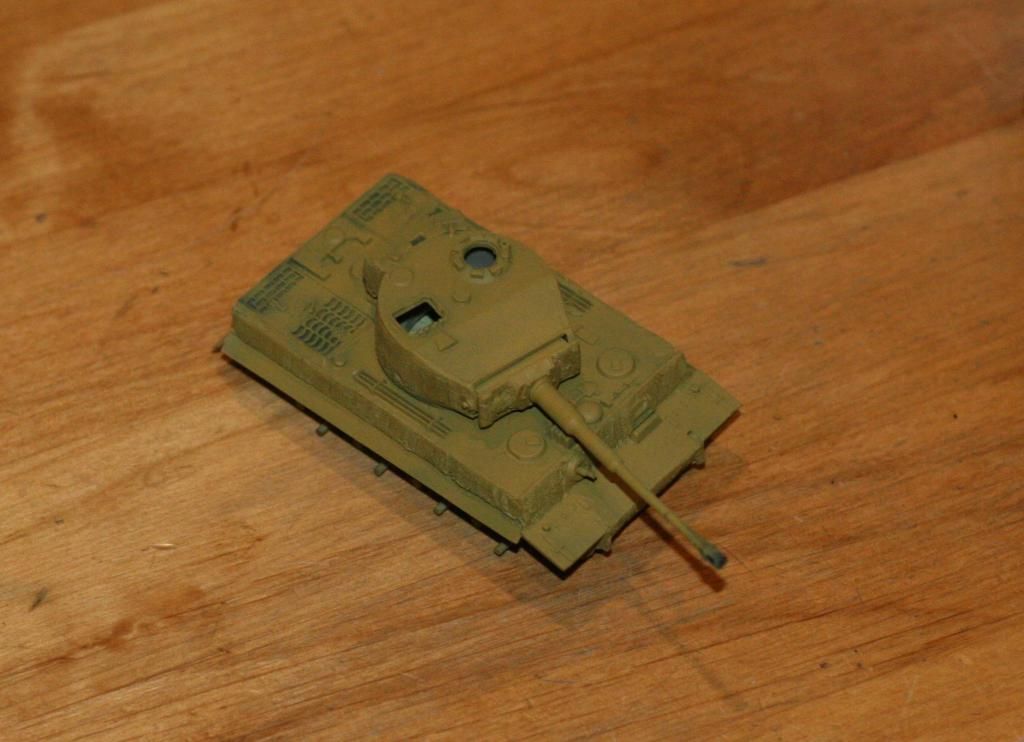

Just got to do the road wheels, decals, a bit of weathering and I'm done. I actually generally don't like building German stuff, but I had this kit in my stash and I thought I'd build it.
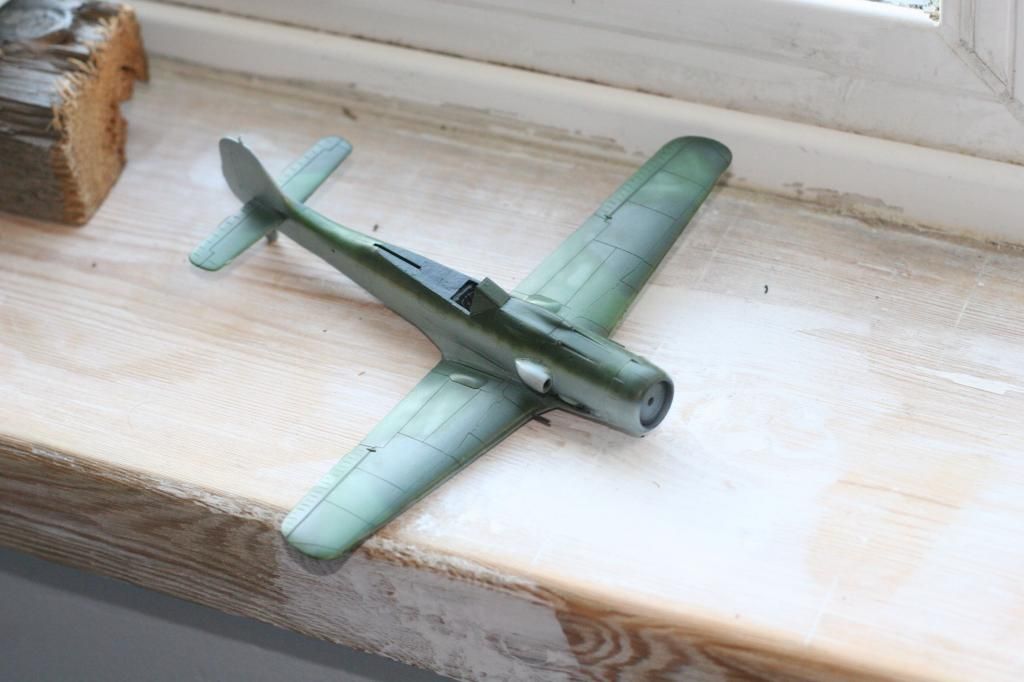
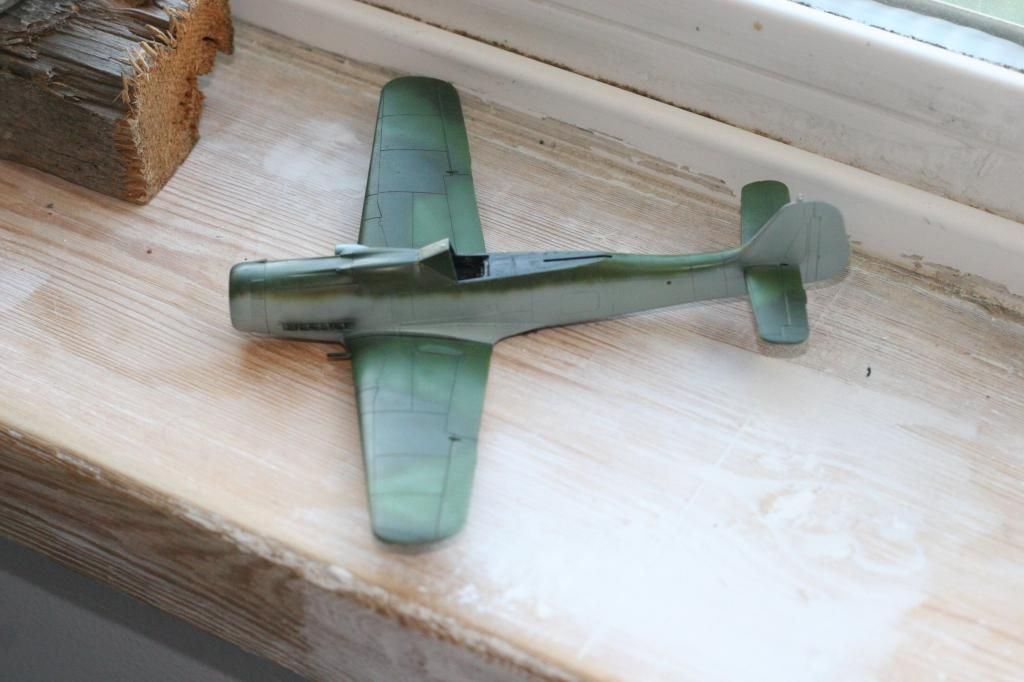
Another project that's almost done is a B5N Kate Bomber, with tons of photo etch.
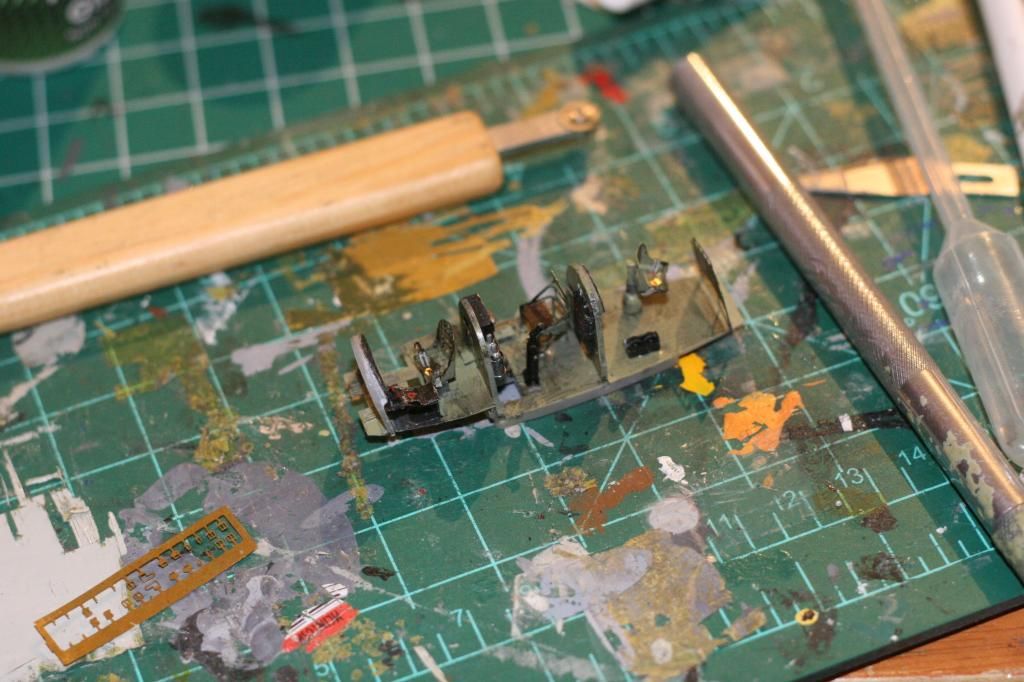
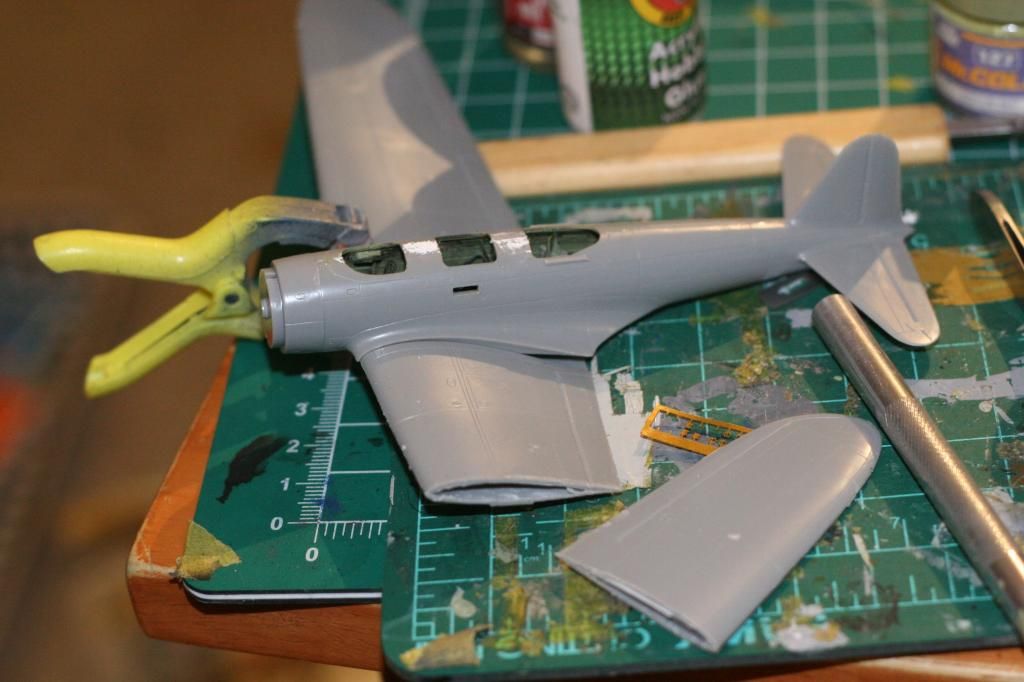
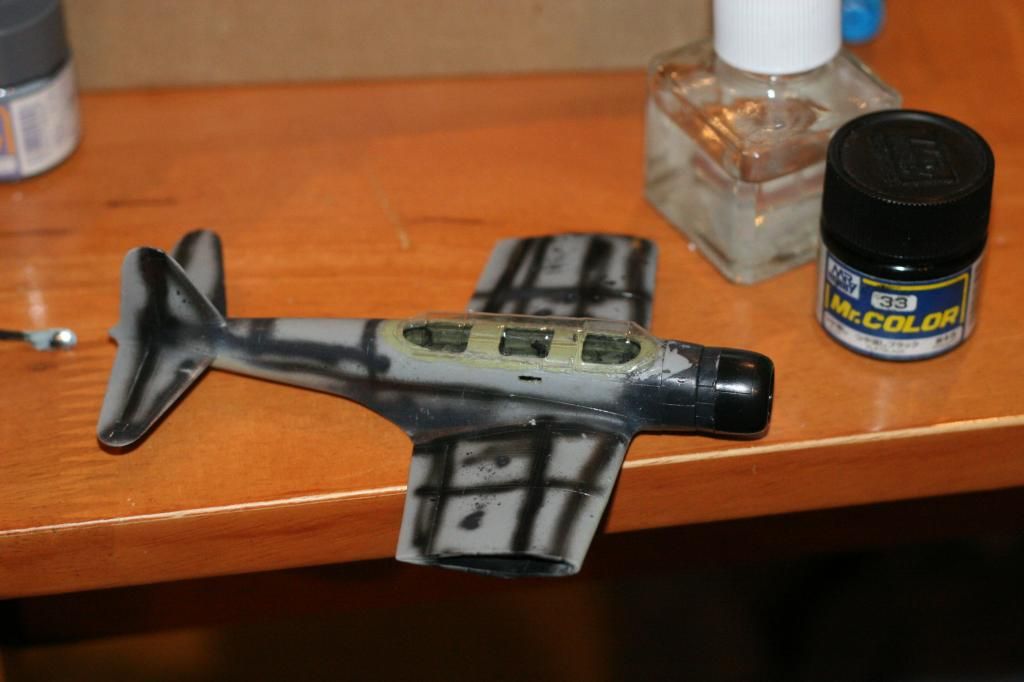
And a couple of korean war aircraft.
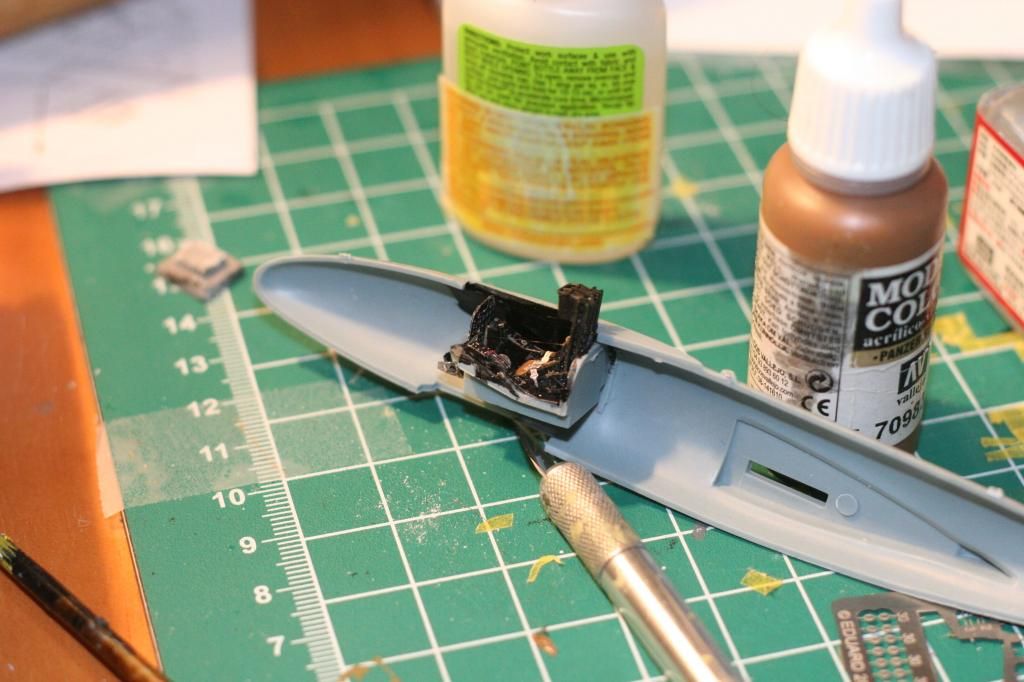
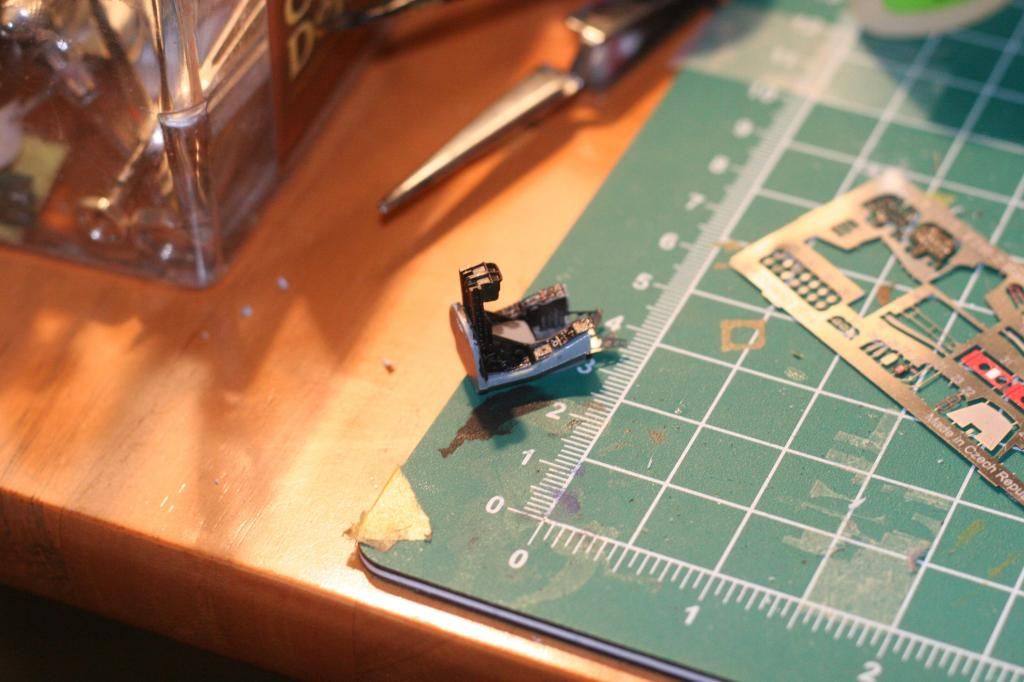
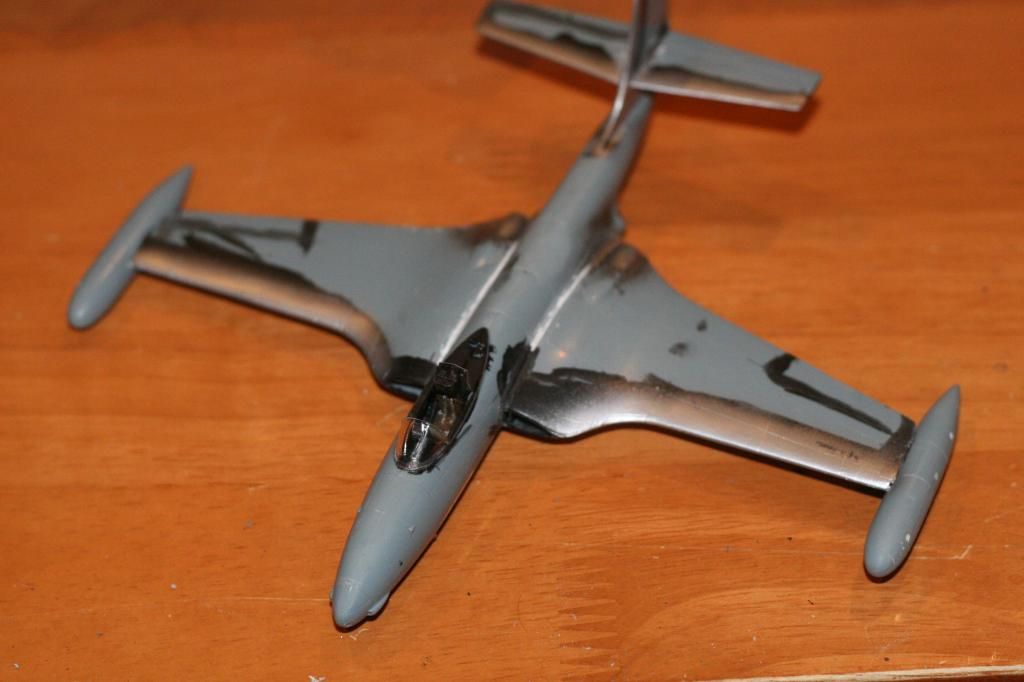
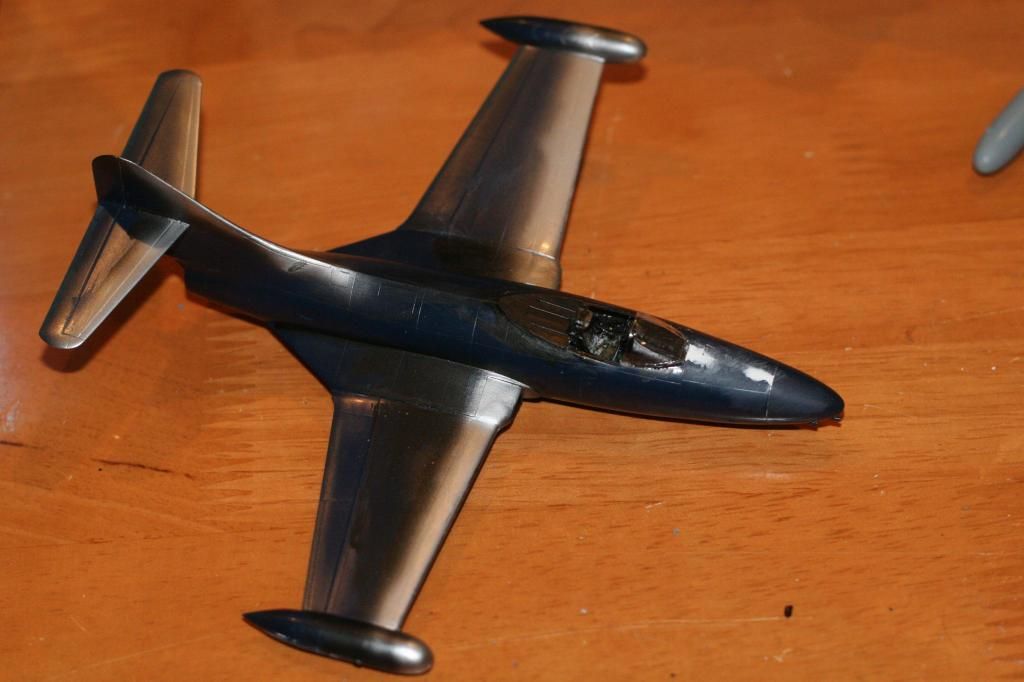
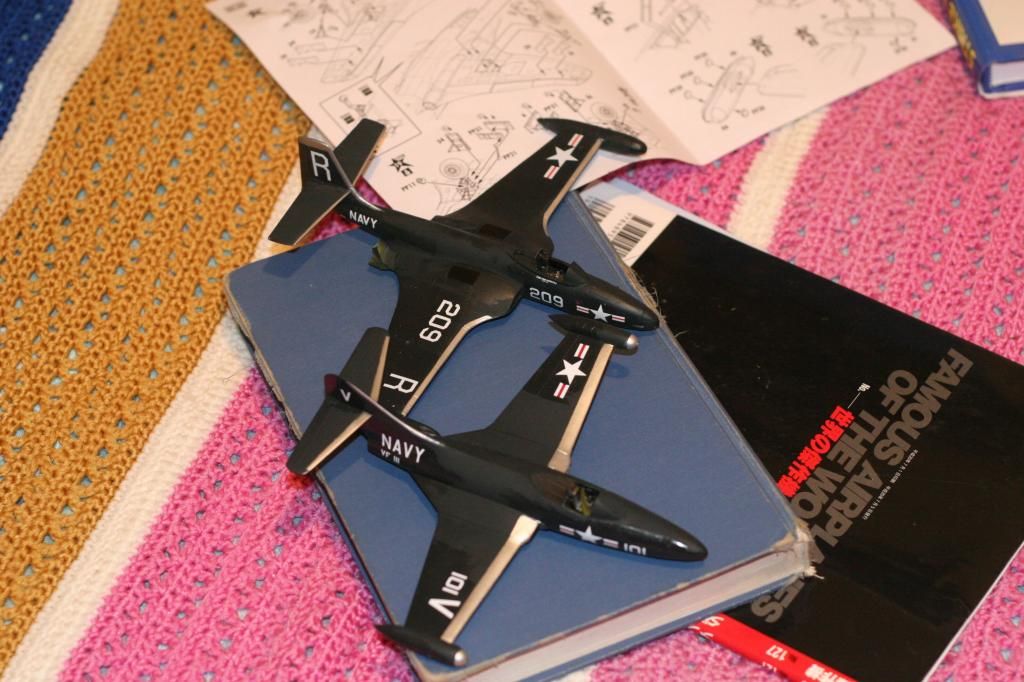
Oh, and one more: a star fighter.
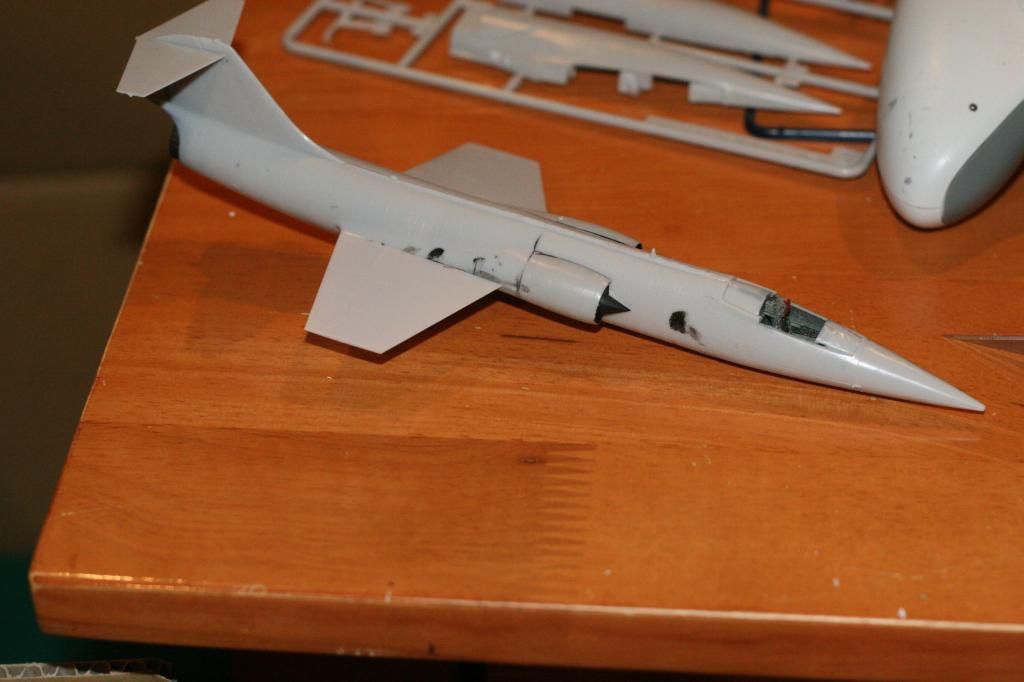
That's it for now... maybe some completed shots next time.
Whats Lying on your Workbench MK IV
in The Workshop!
Posted · Edited by Noyhauser
If it is as I think it is, it won't help. That will just cover over the issue, when the CA will have altered the properties of the plastic/acrylic. Really there is nothing you can do, save for painting over the entire thing a different colour.
I wish I had a photo of a kit's canopy I crazed, but I don't... sufficed to say I've ruined a number of canopies and needed to replace them due to this problem.